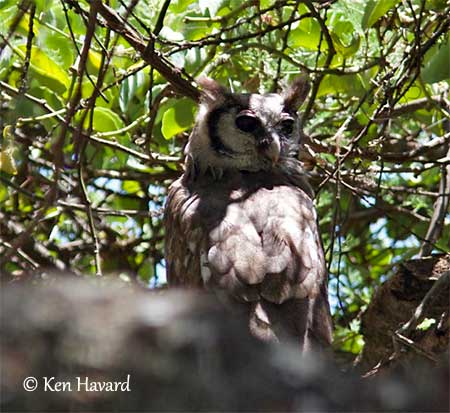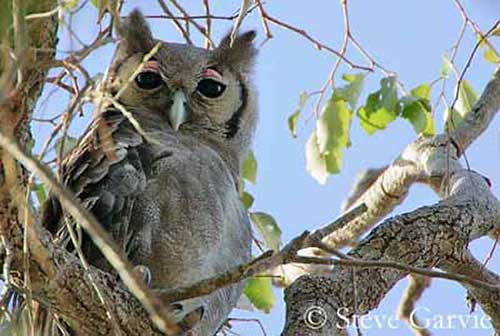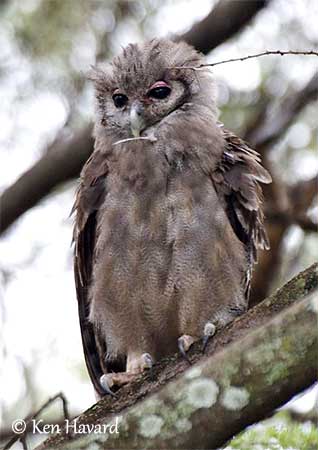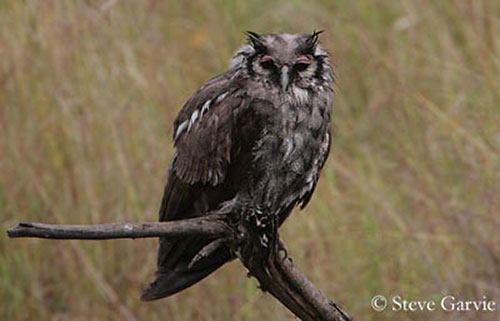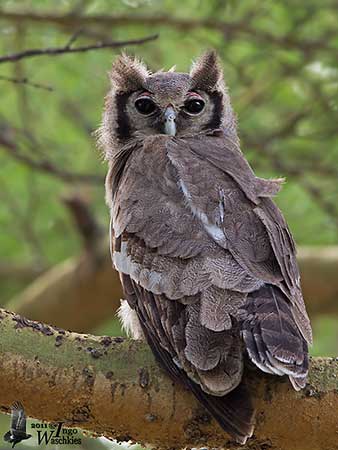
Verreaux’s Eagle Owl
Bubo lacteus
Strigiforme Order – Strigidae Family
BIOMETRICS:
Length: 66-71 cm ; Wingspan: 143 cm ; Weight: M: 1615-1960 g – F: 2475-3115 g
DESCRIPTION:
Verreaux’s Eagle Owl is one of the largest owls. Also known as the Milky Eagle Owl because its colour, and Giant Eagle Owl, because its size. It is a very large and huge, powerful owl, with ear tufts on the head.
Verreaux’s Eagle Owl adult has pale grey-brown plumage, with fine white vermiculations. Throat is white, very conspicuous when calling. Scapulars show white outer webs. Flight feathers and tail are dark, dusky brown, with broad pale grey bars.
Facial disks are pale grey-brown with broad dusky brown rim. Ear tufts are grey-brown with fine pale vermiculations. We can see black nasal bristles at base of the bill. Bill is pale cream with blue-grey cere. Eyes are dark brown, with conspicuous bare deep pink eyelids. Feathered legs are whitish finely barred with grey. Strong feet are pale brown.
Both sexes are similar in plumage, but female is about 13% larger than male.
Juvenile has grey-brown down on body and head, with broad, dark bars. Ears tufts are indistinct at fledging. It moults into adult plumage.
VOICE: SOUNDS BY XENO-CANTO
Verreaux’s Eagle Owl utters far-carrying deep, nasal grunts, often repeated “whuuc-whuuc-whuuc”. We can also hear others deep, gruff grunts “hok hok – hok hok” in regular sequence. It begins to call when emerges at dusk from its roost, and sometimes, a pair may call in tandem.
HABITAT:
Verreaux’s Eagle Owl lives from arid semi-desert, to moist, tall woodlands. It frequents areas with well-developed trees, dry savannah woodlands and places bordering forests and thickets. It is absent from treeless desert and continuous forest, but it is common in open woodlands.
RANGE:
Verreaux’s Eagle Owl is widespread in sub-Saharan Africa, but absent from Namibian desert and tropical rainforest. It is less common and more local in western, than in eastern and southern Africa.
Verreaux’s Eagle Owl pair needs a large territory for breeding, from March to September. Density is sometimes of about one pair per 7.000 hectares, but usually, pairs are spaced at an average interval of 9,5 km to 22 km along rivers. During the breeding season, pairs remain in the vicinity of their nest.
FLIGHT:
Verreaux’s Eagle Owl flies with deep, strong wing beats. It has long, broad wings.
REPRODUCTION:
Verreaux’s Eagle Owl nests in abandoned nests of other species, such as eagles, vultures, crows or Hammerkops. In the Kalahari, they nest on the top of huge nests of Sociable Weavers. Nest is made with sticks.
Female lays two large, round white eggs in June, July or August. Incubation lasts about 38 days, by female which remains on the nest while male brings food for both.
The first chick to hatch is fed by both parents. If food resources are not abundant, the second chick dies. But is food is abundant, two chicks will be reared.
The surviving chick, or the two, leaves the nest at about 9 weeks old, and usually before it can fly. It will remain with parents for up to three months.
We can find prey remains and pellets accumulated near the nest.
Fr: Grand duc de Verreaux
All : Blaßuhu
Esp : Búho Lechoso
Ital : Gufo latteo
Nd : Verreaux-oehoe
Russe : Филин бледный
Photographers:
Steve Garvie
RAINBIRDER Photo galleries & Flickr Rainbirder
Ken Havard
My Bird Gallery & Flickr gallery 1 & Flickr gallery 2
Ingo Waschkies
My bird pictures on Pbase
Text by Nicole Bouglouan
Sources:
HANDBOOK OF THE BIRDS OF THE WORLD Vol 5 by Josep del Hoyo-Andrew Elliott-Jordi Sargatal - Lynx Edicions - ISBN: 8487334253
BIRDS OF AFRICA SOUTH OF THE SAHARA by Ian Sinclair and Peter Ryan - Princeton University Press Princeton and Oxford - ISBN: 0691118159
Wikipedia (Wikipedia, The Free Encyclopedia)
BEHAVIOUR:
Verreaux’s Eagle Owl is a nocturnal species, sometimes seen perched on exposed branches during the day. It usually hunts at dusk, and also may wade into water to catch some fish. Verreauxs’ Eagle owl hunts a wide variety of preys, from moths to Great-White Egrets and other large birds. It also hunts mammals as domestic cats and hedgehogs (It is famed for its habits of “peeling” hedgehogs, and discarding the pelt with the spines attached). It also kills very numerous rats.
When roosting during the day, it sleeps lightly, and may awaken very quickly to defend itself if attacked. It roosts among dense foliage in large trees, often in pair. It is mainly nocturnal and silent.
DIET:
Verreaux’s Eagle Owl feeds on a wide variety of preys, such as birds, game birds, ducks, crows and nestling herons, but also mammals such as hedgehogs, hares, mongooses, small rodents. They also consume frogs, beetles and crickets.
PROTECTION / THREATS / STATUS :
Verreaux’s Eagle Owl is uncommon to locally common resident in its range. Populations are not globally threatened and not yet considered endangered.

